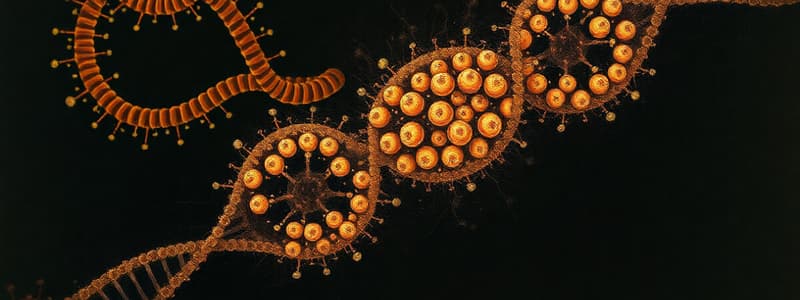Podcast
Questions and Answers
What is the primary function of RNA polymerase in prokaryotic transcription?
What is the primary function of RNA polymerase in prokaryotic transcription?
- To modify RNA through capping and splicing
- To initiate and terminate transcription exclusively
- To synthesize all types of RNA (correct)
- To synthesize only mRNA
Which component is necessary for the initiation of transcription in eukaryotes?
Which component is necessary for the initiation of transcription in eukaryotes?
- Promoter region only
- RNA polymerase alone
- Pre-initiation complex with general transcription factors (correct)
- Rho factor
During transcription in prokaryotes, what happens when RNA polymerase encounters a termination signal?
During transcription in prokaryotes, what happens when RNA polymerase encounters a termination signal?
- Introns are removed
- Transcription continues indefinitely
- Transcription stops (correct)
- Polyadenylation occurs
What type of RNA is synthesized by RNA polymerase I in eukaryotes?
What type of RNA is synthesized by RNA polymerase I in eukaryotes?
What distinguishes the promoter region in eukaryotes from that in prokaryotes?
What distinguishes the promoter region in eukaryotes from that in prokaryotes?
Which of the following is NOT a post-transcriptional modification in eukaryotes?
Which of the following is NOT a post-transcriptional modification in eukaryotes?
What is the main difference in the RNA polymerases found in prokaryotes versus eukaryotes?
What is the main difference in the RNA polymerases found in prokaryotes versus eukaryotes?
Which of the following statements best characterizes the location of transcription in prokaryotes?
Which of the following statements best characterizes the location of transcription in prokaryotes?
Flashcards are hidden until you start studying
Study Notes
Transcription in Prokaryotes
- Definition: Transcription is the process of synthesizing RNA from a DNA template.
- Location: Occurs in the cytoplasm.
- Key Features:
- RNA Polymerase: Single type of RNA polymerase responsible for synthesizing all types of RNA (mRNA, tRNA, rRNA).
- Promoter Region: Transcription begins at specific DNA sequences called promoters (e.g., -10 and -35 regions).
- Initiation: RNA polymerase binds to the promoter, unwinding the DNA and initiating RNA synthesis.
- Elongation: RNA polymerase moves along the DNA, adding nucleotides to the growing RNA chain in a 5' to 3' direction.
- Termination: Transcription stops when RNA polymerase encounters a termination signal (e.g., rho-dependent or rho-independent mechanisms).
- Post-Transcriptional Modifications: Minimal; primary transcripts are often immediately usable without extensive modification.
Transcription in Eukaryotes
- Definition: Similar process of synthesizing RNA from a DNA template.
- Location: Occurs in the nucleus, with mRNA processing occurring before translation in the cytoplasm.
- Key Features:
- RNA Polymerases: Three types (I, II, III) for synthesizing different RNA types:
- RNA Polymerase I: rRNA (except 5S rRNA)
- RNA Polymerase II: mRNA and some snRNA
- RNA Polymerase III: tRNA, 5S rRNA, and other small RNAs
- Promoter Region: More complex with additional regulatory elements (e.g., TATA box, enhancers).
- Initiation: Requires the formation of a pre-initiation complex (PIC) with general transcription factors.
- Elongation: Similar to prokaryotes, but involves various elongation factors.
- Termination: Involves specific sequences and proteins; often includes a polyadenylation signal for mRNA.
- RNA Polymerases: Three types (I, II, III) for synthesizing different RNA types:
- Post-Transcriptional Modifications:
- Capping: 5' cap added to mRNA for stability and recognition.
- Polyadenylation: Addition of a poly-A tail at the 3' end.
- Splicing: Removal of introns and joining of exons to form mature mRNA.
Comparison
- Location: Prokaryotes (cytoplasm) vs. Eukaryotes (nucleus).
- RNA Polymerases: Single in prokaryotes; multiple types in eukaryotes.
- Initiation Process: Simpler in prokaryotes; more complex in eukaryotes.
- Post-Transcriptional Modifications: Minimal in prokaryotes; extensive in eukaryotes, including capping, polyadenylation, and splicing.
Transcription in Prokaryotes
- Transcription synthesizes RNA from a DNA template, crucial for gene expression.
- Takes place in the cytoplasm of prokaryotic cells.
- Single RNA polymerase type synthesizes mRNA, tRNA, and rRNA.
- Begins at promoter regions in DNA, notably the -10 and -35 sequences.
- RNA polymerase binds to the promoter, unwinds DNA, and starts RNA synthesis.
- RNA elongation proceeds in a 5' to 3' direction as nucleotides are added.
- Transcription terminates when RNA polymerase hits a termination signal, using rho-dependent or rho-independent mechanisms.
- Primary RNA transcripts can be immediately used with minimal post-transcriptional modifications.
Transcription in Eukaryotes
- Similar process to prokaryotes, involving RNA synthesis from DNA.
- Occurs in the nucleus; mRNA processing happens before translation in the cytoplasm.
- There are three RNA polymerase types:
- RNA Polymerase I synthesizes rRNA (excluding 5S rRNA).
- RNA Polymerase II is responsible for mRNA and some snRNA.
- RNA Polymerase III creates tRNA, 5S rRNA, and other small RNAs.
- Promoter regions are complex, featuring additional regulatory elements like the TATA box and enhancers.
- Initiation involves forming a pre-initiation complex (PIC) with general transcription factors, making it more complex than in prokaryotes.
- Elongation occurs similarly to prokaryotes but involves various elongation factors.
- Termination is driven by specific sequences, proteins, and often includes a polyadenylation signal for mRNA.
- Post-transcriptional modifications include:
- Capping: A 5' cap added to mRNA for stability and identification.
- Polyadenylation: A poly-A tail is added to the 3' end of mRNA.
- Splicing: Removal of introns and joining of exons produces mature mRNA.
Comparison between Prokaryotic and Eukaryotic Transcription
- Prokaryotic transcription occurs in the cytoplasm, whereas eukaryotic transcription occurs in the nucleus.
- Prokaryotes possess a single type of RNA polymerase, while eukaryotes have three distinct types.
- The initiation process is straightforward in prokaryotes, contrasted with the complex initiation in eukaryotes involving a PIC.
- Prokaryotic transcription has minimal post-transcriptional modifications, while eukaryotic transcription includes significant modifications like capping, polyadenylation, and splicing.
Studying That Suits You
Use AI to generate personalized quizzes and flashcards to suit your learning preferences.




